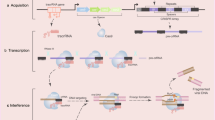Abstract
The history of green fluorescent protein (GFP) as a marker is less than 10 years old, but it has already made a major impact on many areas of natural sciences, especially on cell biology and histochemistry. GFP can be detected in living cells without selection or staining and it can be fused to other proteins to yield fluorescent chimeras. The potential of GFP has also been recognised by gene therapy researchers and various GFP-tagged therapeutic proteins have been constructed. These chimeric proteins have been used to determine the expression level, site and time course of the therapeutic gene, or the correlation between gene transfer rate and therapeutic outcome. This review summarises the status of the applications of GFP fusions in gene therapy research.
Similar content being viewed by others
Author information
Authors and Affiliations
Additional information
Electronic Publication
Rights and permissions
About this article
Cite this article
Wahlfors, J., Loimas, S., Pasanen, T. et al. Green fluorescent protein (GFP) fusion constructs in gene therapy research. Histochem Cell Biol 115, 59–65 (2001). https://doi.org/10.1007/s004180000219
Accepted:
Published:
Issue Date:
DOI: https://doi.org/10.1007/s004180000219




